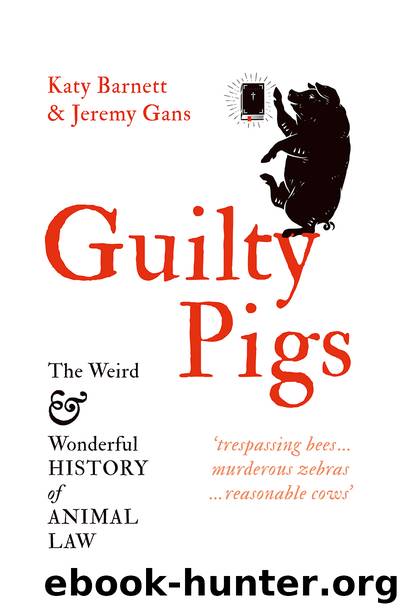Guilty Pigs by Barnett Katy;Gans Jeremy; & Jeremy Gans

Author:Barnett, Katy;Gans, Jeremy; & Jeremy Gans [Barnett, Katy & Gans, Jeremy]
Language: eng
Format: epub
Publisher: Black Inc.
Published: 0101-01-01T00:00:00+00:00
Despite the judgeâs vehement and compelling criticism of Riggsâ and Kodaâs handlers, the case was a vindication of sorts for the dogs themselves, or at least their noses: the house where the man was found turned out to be the home of the stolen carâs passenger, whom the police had successfully arrested after the crash.
Animals as Experts
Earlier, we explained how South Africaâs police played a crucial early role in establishing broad acceptance of the use of tracker dogs. South African police were able to leverage their countryâs racial divisions to convince the public to accept the use of dogs in some settings, which â decades later, and following the widespread use of dogs during World War II â led to the public acceptance of police dogs throughout the developed world. However, the South African courts had a different view on the matter. At an early stage, they baulked at relying on evidence from animal tracking in criminal prosecutions. Indeed, they still baulk at it, although now they are almost alone in taking such a stance. Other courts shifted from treating dogs as beyond understanding in legal settings to accepting that their input can justify police action and criminal punishment.
In 1918, an Eastern Cape court assessed the effectiveness of a typical way dogs in that era were used to track evidence. In one of the matters considered by the court, police investigating stock thefts used a dog to track some footprints to the accusedâs home and then improvised a line-up of sorts. The accused and two others were made to stand 30 yards apart, and the dog was repeatedly instructed to find the source of the footprints and picked the accused each time. The judge in the case, Sir Thomas Graham, a former prime minister of the Cape Colony, endorsed the method as a way to identify possible culprits and encourage them to confess, but drew the line at courts relying on the same method to infer guilt. He ruled that âit would be a dangerous innovation to allow the introduction of the evidence of irrational animals which were actuated by instincts of which we knew but little and could regulate only in a limited degreeâ, likening the evidence to testimony by âlunatics and persons in state of intoxicationâ.
South Africaâs courtroom ban was confirmed the following year by the newly formed Unionâs top court. In this case, a dog had followed the footprints of a prowler to a nearby hostel, sniffed each of the eight occupants and then jumped onto the accusedâs bed, barking at him. South Africaâs most feted jurist, Chief Justice James Rose Innes, pursued the opposite line of reasoning to Graham. The problem with tracker dogs was not their instinctive behaviour, Innes ruled, but rather their trained behaviour:
The habit of a dog to resent the entrance of a stranger at night, is independent of instruction or experience; it is based upon the instinct of self-preservation; and it is patent to our observation. But to draw inferences from the
Download
This site does not store any files on its server. We only index and link to content provided by other sites. Please contact the content providers to delete copyright contents if any and email us, we'll remove relevant links or contents immediately.
The Lonely City by Olivia Laing(4140)
Animal Frequency by Melissa Alvarez(3770)
All Creatures Great and Small by James Herriot(3540)
Walking by Henry David Thoreau(3244)
Exit West by Mohsin Hamid(3211)
Origin Story: A Big History of Everything by David Christian(3151)
COSMOS by Carl Sagan(2967)
How to Read Water: Clues and Patterns from Puddles to the Sea (Natural Navigation) by Tristan Gooley(2893)
Hedgerow by John Wright(2790)
The Inner Life of Animals by Peter Wohlleben(2780)
Origin Story by David Christian(2701)
How to Read Nature by Tristan Gooley(2675)
Project Animal Farm: An Accidental Journey into the Secret World of Farming and the Truth About Our Food by Sonia Faruqi(2673)
How to Do Nothing by Jenny Odell(2658)
Water by Ian Miller(2608)
A Forest Journey by John Perlin(2597)
The Plant Messiah by Carlos Magdalena(2468)
A Wilder Time by William E. Glassley(2373)
Forests: A Very Short Introduction by Jaboury Ghazoul(2347)
